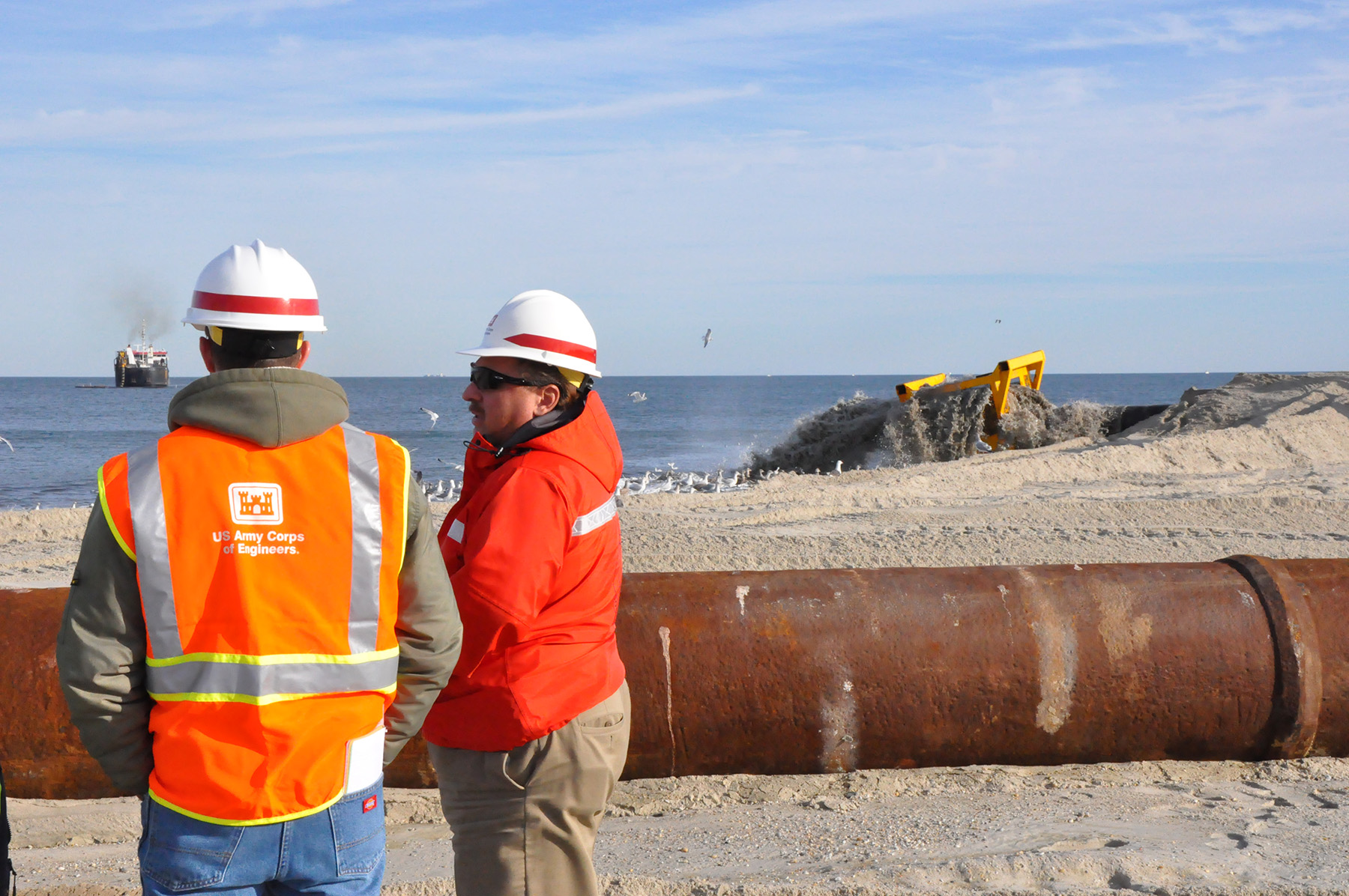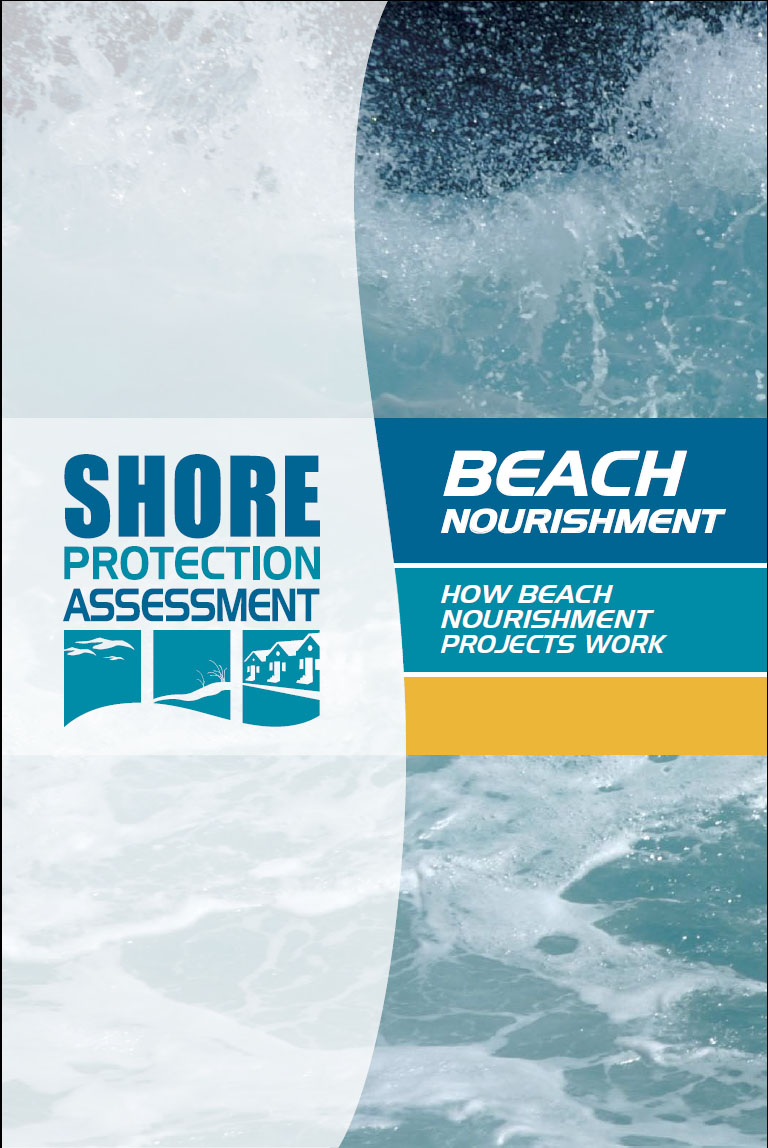
The U.S. Army Corps of Engineers is carrying out near-term coastal restoration work at previously completed coastal storm risk reduction projects throughout the northeast that were impacted by Hurricane Sandy. This involves the placement of millions of cubic yards of sand along beaches impacted by Hurricane Sandy in order to restore them. The New York District of the U.S. Army Corps of Engineers is carrying out that mission in the state of New York and in New Jersey north of Manasquan Inlet. Work south of Manasquan Inlet is managed by the Philadelphia District of the U.S. Army Corps of Engineers (click here for more about their coastal program).
Everything the U.S. Army Corps of Engineers does must be tied to a statutory authority and the ongoing near-term coastal restoration work is generally the result of two statutory authorities, one previously existing and one that is new since Hurricane Sandy.
- Through the Flood Control and Coastal Emergencies (FCCE) Act, PL 84-99, the Corps of Engineers is authorized to repair previously constructed projects after a large event like Hurricane Sandy. Put simply, this pre-existing authority allows the Corps to return the project area to pre-storm conditions.
- Through the Disaster Relief Appropriations Act of 2013 (the Sandy Relief Bill, or PL 113-2), the Corps of Engineers is authorized to restore previously constructed projects severely impacted by Hurricane Sandy. This new authority allows the Corps to restore projects impacted by Hurricane Sandy to their original design profile, which often means placing a great deal more sand during the near-term coastal restoration efforts.

For more information about beach nourishment, how it is done and how it helps reduce risks to coastal communities, you can click here to check out a PDF form of the "How Beach Nourishment Works" information pamphlet from the U.S. Army Corps of Engineers, Engineer Research and Development Center.
Near-Term Coastal Restoration Projects
New York District is carrying out this near-term coastal restoration work at seven project areas in New York and New Jersey, with work covering dozens of miles of coastline:
New York - The U.S. Army Corps of Engineers placed more than 7 million cubic yards of sand in the process of repairing and restoring previously constructed coastal storm risk management beaches in New York.
- Rockaway Beach - The U.S. Army Corps of Engineers completed the placement of roughly 3.5 million cubic yards of sand through two contracts to repair and restore this coastal storm risk management beach project.
- Click here to learn more about the ongoing reformulation study looking at long-term coastal storm risk reduction alternatives for this area
- Coney Island - The U.S. Army Corps of Engineers completed the placement of roughly 600,000 cubic yards of sand to repair and restore this coastal storm risk management beach project.
- Click here to learn more about the next phase of this original coastal storm risk reduction project that will be starting in the Sea Gate community west of Coney Island later this year
- Gilgo Beach - The U.S. Army Corps of Engineers placed roughly 1.5 million cubic yards of sand to complete the repair of this coastal storm risk management beach that is part of dual-purpose navigation (Fire Island Inlet) and coastal storm risk management project and to bolster nearby municipal beaches using additional funds provided by the state of New York.
- Click here to learn more about the existing dual-purpose navigation and coastal storm risk management project (Fire Island and Shores Westerly to Jones Inlet) authorized here
- West of Shinnecock Inlet - The U.S. Army Corps of Engineers placed roughly 450,000 cubic yards of sand to repair and restore this coastal storm risk management beach project.
- Click here to find out more about the ongoing Fire Island to Montauk Point Reformulation Study that this project is an interim spin-off from
- Westhampton - The U.S. Army Corps of Engineers has awarded a construction contract for this work and expects to oversee the placement of roughly 1 million cubic yards of sand by the end of this year to repair and restore this coastal storm risk management beach project.
- Click here to find out more about the ongoing Fire Island to Montauk Point Reformulation Study that this project is an interim spin-off from
The U.S. Army Corps of Engineers also repaired the previously constructed coastal storm risk reduction project at Oakwood Beach on Staten Island, though this smaller project did not originally include sand placement elements and the repair work, carried out through authorities from the Flood Control and Coastal Emergencies Act, primarily involved levee and tide gate work.
- Click here to find out more about the ongoing feasibility study looking at coastal storm risk reduction alternatives for the entire south shore of Staten Island
New Jersey - More than 18 million cubic yards of sand was placed throughout the state through this near-term coastal restoration work, including the two projects below managed by New York District as well as work further south in New Jersey being managed by the Philadelphia District of the U.S. Army Corps of Engineers.
- Keansburg - The U.S. Army Corps of Engineers placed roughly 875,000 cubic yards of sand to repair and restore this coastal storm risk management beach project. The repair and restore work also included repairs to eroded levees, repairs to the damaged wingwall adjacent to the tide gate and removal of debris along the levees.
- Sea Bright to Manasquan (includes several communities along the Atlantic Coast of New Jersey) - The U.S. Army Corps of Engineers placed roughly 8 million cubic yards of sand through four contracts to repair and restore this previously constructed coastal storm risk management beach project.
- Click here for more information on the original Sea Bright to Manasquan erosion control and storm risk reduction project
Please note that the information in the above fact sheets is subject to updates/changes. Please feel free to call the public affairs office at 917-790-8007 or e-mail the public affairs office at CENAN-PA@usace.army.mil if you have any questions regarding the projects above.
Click here for B-Roll videos from project sites: As available, New York District public affairs will post B-Roll of construction on these projects for interested media